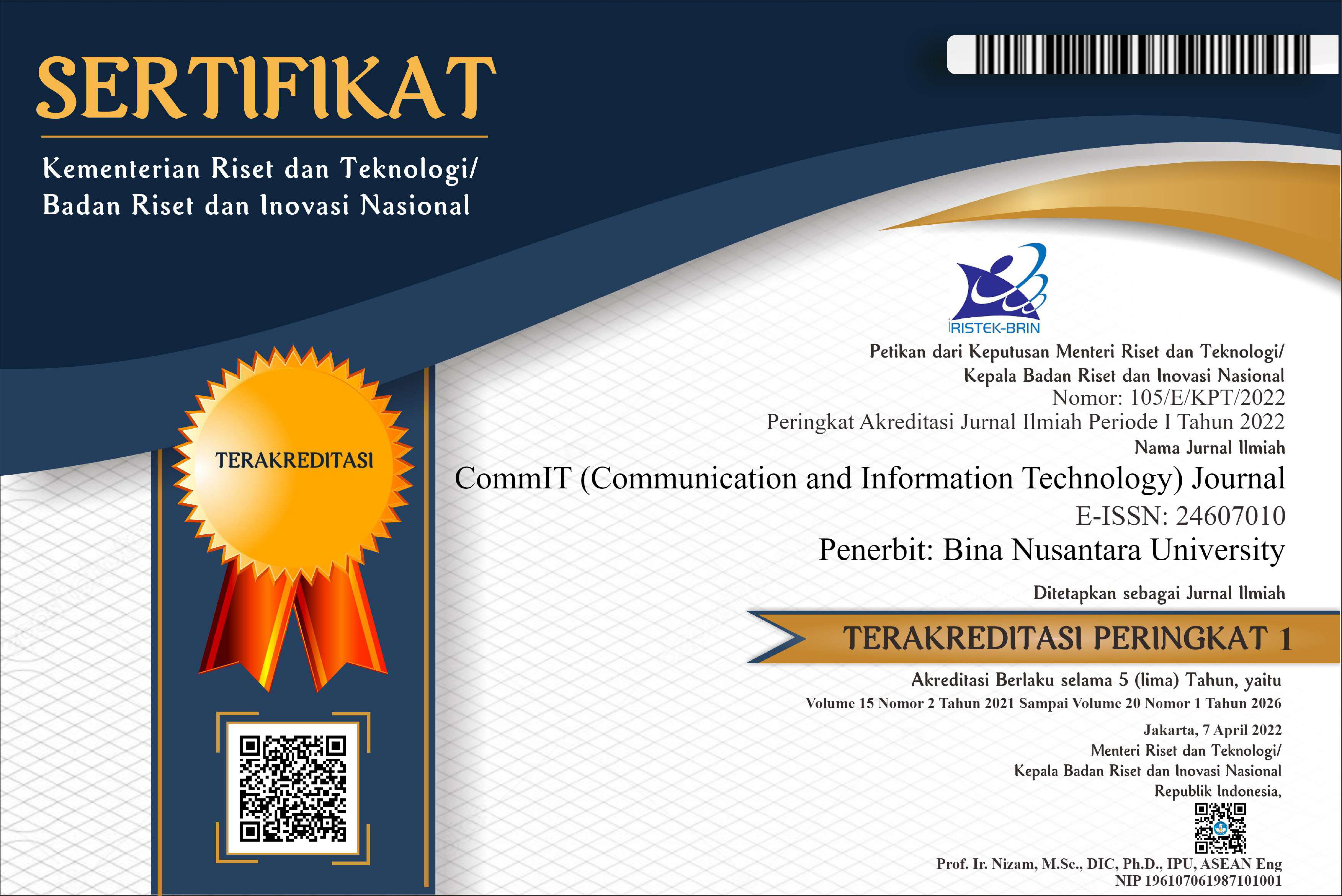A Study of Customer Satisfaction on Online Trading System Application of Securities Company in Indonesia Using Servqual
DOI:
https://doi.org/10.21512/commit.v9i1.1651Keywords:
Customer Satisfaction, Service Quality, On- line TradingAbstract
The purpose of this study is to measure the service quality of online trading system implemented by PT KDB Daewoo Securities Indonesia. The study is a part of the company efforts to provide the best solution services. The study is performed to determine the influence of service quality factors on the customer satisfaction by means of ServQual method. The method takes into account five independent variables, namely, reliability (X1 ), responsiveness (X2 ), assurance (X3 ), empathy (X4 ), and tangibility (X5 ). Meanwhile, the cus- tomer satisfaction is considered as the dependent variable (Y ). The population of of the study is all 67 900 online traders at the company and the sample size is 265 traders. The data are collected via questionnaires and interviews. From the study results, we conclude that the five variables have significant influence on the customer satisfaction on the online trading system application at PT KDB Daewoo Securities Indonesia. To improve the customer satisfaction, the company should prioritize the quality- related factors, and expand and upgrade the existing facilities and infrastructures.
Plum Analytics
References
F. Vakil and F. V. Lu, “The effect of the internet on stock market volume and volatility,” Review of Business, vol. 26, no. 3, pp. 26–30, 2005.
R. DeYoung, “The performance of internet-based business models: Evidence from the banking in- dustry*,” The Journal of Business, vol. 78, no. 3, pp. 893–948, 2005.
C. Marston and A. Polei, “Corporate reporting on the internet by german companies,” Interna- tional Journal of Accounting Information Sys- tems, vol. 5, no. 3, pp. 285–311, 2004.
D. Buhalis, “eairlines: strategic and tactical use of icts in the airline industry,” Information & Management, vol. 41, no. 7, pp. 805–825, 2004.
E. K. Clemons and L. M. Hitt, “The internet and the future of financial services: Transparency, dif- ferential pricing and disintermediation,” Wharton School Center for Financial Institutions, Univer- sity of Pennsylvania, Tech. Rep., 2000.
H. Linda, “Home online trading system,” Indone- sia Stock Journal, vol. 8, pp. 11–15, 2012.
R. S. Wilton and D. L. Silverman, “Electronic trading system featuring arbitrage and third-party credit opportunities,” Feb. 11 2003, uS Patent
,519,574.
J. B. Skjærseth and J. Wettestad, “Fixing the eu emissions trading system? understanding the post-2012 changes,” Global Environmental Poli- tics, vol. 10, no. 4, pp. 101–123, 2010.
J. J. Schott, “Free trade agreements: boon or bane of the world trading system,” Free Trade Agreements: US Strategies and Priorities, vol. 3, no. 11, 2004.
J. J. Cronin Jr and S. A. Taylor, “Servperf ver- sus servqual: reconciling performance-based and perceptions-minus-expectations measurement of service quality,” The Journal of Marketing, vol. 2, pp. 125–131, 1994.
J. Tribe and T. Snaith, “From servqual to holsat: holiday satisfaction in varadero, cuba,” Tourism Management, vol. 19, no. 1, pp. 25–34, 1998.
J. E. Collier and C. C. Bienstock, “A concep- tual framework for measuring e-service quality,” in Creating and Delivering Value in Marketing. Springer, 2015, pp. 158–162.
Y.-S. Wang and T.-I. Tang, “Assessing customer perceptions of website service quality in digi- tal marketing environments,” Journal of Orga- nizational and End User Computing (JOEUC), vol. 15, no. 3, pp. 14–31, 2003.
E. Babakus and M. Inhofe, “Measuring perceived service quality as a multi-attribute attitude,” in
Proceedings of the 1993 Academy of Marketing
Science (AMS) Annual Conference. Springer,
, pp. 376–380.
P. Bharati and A. Chaudhury, “Product cus- tomization on the web: an empirical study of factors impacting choiceboard user satisfaction,” Bharati, P. and Chaudhury, A.(2006),Product Customization on the Web: An Empirical Study of Factors Impacting Choiceboard User Satisfac- tion, Information Resources Management Jour- nal, vol. 19, no. 2, pp. 69–81, 2015.
S. A. Kaynama, “A conceptual model to measure service quality of online companies: E-qual,” in Proceedings of the 2000 Academy of Marketing Science (AMS) Annual Conference. Springer,
, pp. 46–51.
A. Parasuraman, V. A. Zeithaml, and L. L. Berry, “Reassessment of expectations as a comparison standard in measuring service quality: implica- tions for further research,” The journal of Mar- keting, vol. 58, pp. 111–124, 1994.
Y. Ben-Haim, “Info-gap economics,” Environ- mental Management, vol. 87, pp. 443–449, 2010.
S. E. Black and L. M. Lynch, “How to compete: the impact of workplace practices and infor- mation technology on productivity,” Review of Economics and statistics, vol. 83, no. 3, pp. 434–
, 2001.
M. D. Chinn and R. W. Fairlie, “The determinants of the global digital divide: a cross-country analy- sis of computer and internet penetration,” Oxford Economic Papers, 2006.
B. N. Sethna, “Extensions and testing of importance-performance analysis,” in Proceed- ings of the 1982 Academy of Marketing Science (AMS) Annual Conference. Springer, 2015, pp.
–331.
Downloads
Published
Issue
Section
License
Authors who publish with this journal agree to the following terms:
a. Authors retain copyright and grant the journal right of first publication with the work simultaneously licensed under a Creative Commons Attribution License - Share Alike that allows others to share the work with an acknowledgment of the work's authorship and initial publication in this journal.
b. Authors are able to enter into separate, additional contractual arrangements for the non-exclusive distribution of the journal's published version of the work (e.g., post it to an institutional repository or publish it in a book), with an acknowledgment of its initial publication in this journal.
c. Authors are permitted and encouraged to post their work online (e.g., in institutional repositories or on their website) prior to and during the submission process, as it can lead to productive exchanges, as well as earlier and greater citation of published work.
USER RIGHTS
All articles published Open Access will be immediately and permanently free for everyone to read and download. We are continuously working with our author communities to select the best choice of license options, currently being defined for this journal as follows: Creative Commons Attribution-Share Alike (CC BY-SA)




















